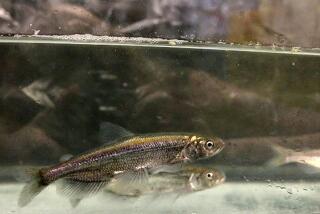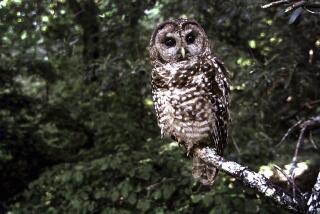COMMENTARIES ON THE ENVIRONMENT : Gnatcatcher: Imperiled Species or Specious No-Growth Ploy? : Experts say the tiny songbird is on the verge of extinction, with up to 90% of its habitat of coastal sage scrub lost.
- Share via
The California gnatcatcher is a tiny songbird at the heart of a growing storm of environmental controversy. Building industry representatives have called the bird their “worst nightmare.” Federal wildlife protection officials have likened it to “our miner’s canary,” with its demise portending the death of an entire ecosystem of plant and animal species that have inhabited our coastal areas for centuries.
The gnatcatcher and its coastal chaparral habitat are on the verge of extinction. Experts estimate that 70% to 90% of its habitat, called coastal sage scrub, has already been destroyed by urban and agricultural development. The total gnatcatcher population has dwindled to an estimated 1,500 pairs.
Intense development planned for Orange, San Diego and Riverside counties threatens what remains of the chaparral that historically blanketed the coast from the Mexican border to the central coast. With the loss and further fragmentation of this habitat, experts agree that the gnatcatcher cannot survive.
To protect the gnatcatcher and our remaining coastal ecosystem, the Natural Resources Defense Council and the Manomet Bird Observatory have filed petitions with state and federal wildlife protection agencies requesting that the gnatcatcher be listed immediately as endangered.
Endangered species laws currently provide the only mechanism available to ensure the survival of the gnatcatcher and prevent the habitat destruction that has occurred at an ever-increasing rate over the past 20 years. In addition to the gnatcatcher, about 50 other endangered or threatened plant and animal species inhabit and depend upon coastal sage scrub. Their fate, too, hangs in the balance.
Meaningful voluntary efforts to save the gnatcatcher or its habitat have simply not materialized. In fact, unprecedented opposition to any state or federal protection has been generated by the development community, including major landholders and a coalition of local governments in Orange County that seeks to build toll roads through the two largest remaining stretches of undeveloped contiguous coastal sage scrub in Southern California.
Unfortunately, these property owners have stubbornly refused to allow access to their lands for study by scientists or even to reveal species census data gathered by their own consultants. Instead, they dismiss the danger to the gnatcatcher, and they predict an economic apocalypse, with hundreds of millions of dollars in lost real estate, if the listing petitions are approved.
Their fears are unwarranted. In enacting the endangered-species laws, Congress flatly rejected the claim that economic paralysis is an inevitable result of preservation of our natural wildlife heritage. Listing of the gnatcatcher will not stop growth in Orange, San Diego or Riverside counties; permits can and will be issued for projects involving coastal sage scrub.
Listing will simply ensure that development is compatible with proper maintenance, management, and restoration of a species and an ecosystem whose very existence is at risk. This minimal protection is essential if we are to maintain a biologically diverse environment and prevent potentially massive extinctions in the face of Southern California’s unprecedented population growth and accelerating development.
Rather than cause for repeal of endangered-species laws, the gnatcatcher--like the spotted owl in the Northwest--is the latest reminder of the need for cooperation and innovation among affected interests, from conservationists to builders. The National Resources Defense Council believes that this most recent controversy presents a unique opportunity to begin a cooperative process of identifying and protecting essential habitat on a rational, biologically sound, multispecies basis. Through this process, all interests can contribute to and benefit from the preservation of our wildlife heritage before it’s too late.
The gnatcatcher is no one’s “worst nightmare.” Too long ignored, it must now be protected by listing to prevent its extinction and the unmitigated destruction of its habitat. But no one is well served by continued confrontation as species after species is threatened with extinction. Everyone would benefit from serious habitat conservation planning, not as a substitute for listing but in conjunction with it, and not just for the gnatcatcher but for the full range of species that depend upon coastal sage scrub for survival.
Editor’s note: The state Fish and Game Commission will meet Thursday in Newport Beach to decide whether to list the gnatcatcher as endangered. These columns present arguments supporting and opposing the petition to protect the bird.
More to Read
Sign up for Essential California
The most important California stories and recommendations in your inbox every morning.
You may occasionally receive promotional content from the Los Angeles Times.













